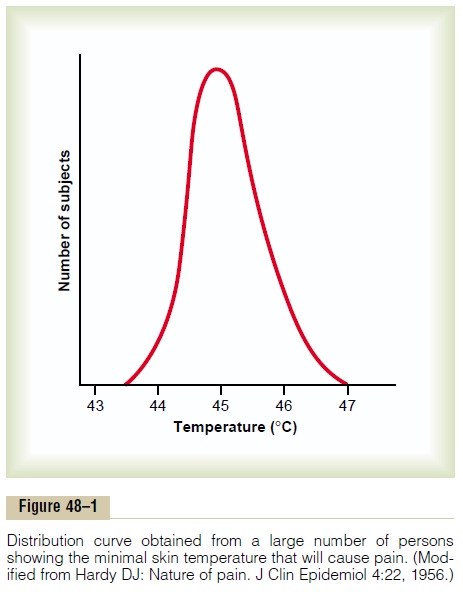Chapter: Medical Physiology: Somatic Sensations: II. Pain, Headache, and Thermal Sensations
Pain Receptors and Their Stimulation
Pain Receptors and Their Stimulation
Pain Receptors Are Free Nerve Endings. The pain receptors in the skin and othertissues are all free nerve endings. They are widespread in the superficial layers of the skin as well as in certain internal tissues, such as the periosteum, the arte-rial walls, the joint surfaces, and the falx and tentorium in the cranial vault. Mostother deep tissues are only sparsely supplied with pain endings; nevertheless, any widespread tissue damage can summate to cause the slow-chronic-aching type of pain in most of these areas.
Three Types of Stimuli Excite Pain Receptors—Mechanical, Thermal, and Chemical. Pain can be elicited by multipletypes of stimuli. They are classified as mechanical,thermal, andchemical pain stimuli. In general, fast painis elicited by the mechanical and thermal types of stimuli, whereas slow pain can be elicited by all three types.
Some of the chemicals that excite the chemical type of pain are bradykinin, serotonin, histamine, potassiumions, acids, acetylcholine, and proteolytic enzymes. Inaddition,prostaglandins and substance P enhance the sensitivity of pain endings but do not directly excite them. The chemical substances are especially impor-tant in stimulating the slow, suffering type of pain that occurs after tissue injury.
Nonadapting Nature of Pain Receptors. In contrast to mostother sensory receptors of the body, pain receptors adapt very little and sometimes not at all. In fact, under some conditions, excitation of pain fibers becomes progressively greater, especially so for slow-aching-nauseous pain, as the pain stimulus continues.This increase in sensitivity of the pain recep-tors is called hyperalgesia. One can readily understand the importance of this failure of pain receptors to adapt, because it allows the pain to keep the person apprised of a tissue-damaging stimulus as long as it persists.
Rate of Tissue Damage as a Stimulus for Pain
The average person begins to perceive pain when the skin is heated above 45°C, as shown in Figure 48–1. This is also the temperature at which the tissues begin to be damaged by heat; indeed, the tissues are even-tually destroyed if the temperature remains above this level indefinitely. Therefore, it is immediately apparent that pain resulting from heat is closely correlated with the rate at which damage to the tissues is occur-ring and not with the total damage that has alreadyoccurred.

The intensity of pain is also closely correlated with the rate of tissue damage from causes other than heat, such as bacterial infection, tissue ischemia, tissue con-tusion, and so forth.
Special Importance of Chemical Pain Stimuli During Tissue Damage. Extracts from damaged tissue cause intensepain when injected beneath the normal skin. Most of the chemicals listed earlier that excite the chemical pain receptors can be found in these extracts. One chemical that seems to be more painful than others is bradykinin. Many researchers have suggested thatbradykinin might be the agent most responsible for causing pain following tissue damage. Also, the inten-sity of the pain felt correlates with the local increase in potassium ion concentration or the increase in pro-teolytic enzymes that directly attack the nerve endings and excite pain by making the nerve membranes more permeable to ions.
Tissue Ischemia as a Cause of Pain. When blood flow to atissue is blocked, the tissue often becomes very painful within a few minutes. The greater the rate of metabo-lism of the tissue, the more rapidly the pain appears. For instance, if a blood pressure cuff is placed around the upper arm and inflated until the arterial blood flow ceases, exercise of the forearm muscles sometimes can cause muscle pain within 15 to 20 seconds. In the absence of muscle exercise, the pain may not appear for 3 to 4 minutes even though the muscle blood flow remains zero.
One of the suggested causes of pain during ischemia is accumulation of large amounts of lactic acid in the tissues, formed as a consequence of anaerobic metab-olism (metabolism without oxygen). It is also proba-ble that other chemical agents, such as bradykinin and proteolytic enzymes, are formed in the tissues because of cell damage and that these, in addition to lactic acid, stimulate the pain nerve endings.
Muscle Spasm as a Cause of Pain. Muscle spasm is alsoa common cause of pain, and it is the basis of many clinical pain syndromes. This pain probably results partially from the direct effect of muscle spasm in stimulating mechanosensitive pain receptors, but it might also result from the indirect effect of muscle spasm to compress the blood vessels and cause ischemia. Also, the spasm increases the rate of metab-olism in the muscle tissue, thus making the relative ischemia even greater, creating ideal conditions for the release of chemical pain-inducing substances.
Related Topics